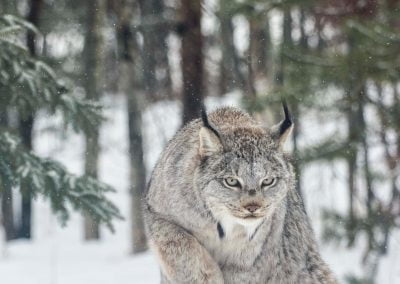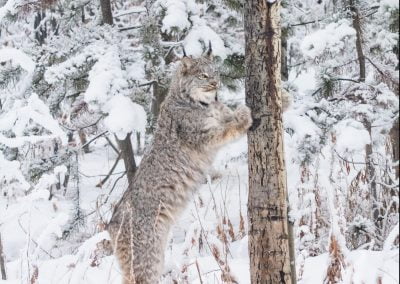
Leaps and Bounds “Winter is Here”-Lynx
9 minute read – “Winter Is Here” series continues with the elusive enigma – Lynx!
I, for one, love winter. What a unique time of year it is to be able to get outside in the short but cherished sunlight hours or total darkness for a hike, ski, or skate, then get inside and warm up by a fire. Of course Yukon’s wildlife call the outdoors their home but don’t worry they are just fine outside.
With those view-blocking leaves off the trees and the snow piled high, the Preserve’s most elusive resident – the lynx, becomes ever so slightly easier to spot in their habitat.
The lynx is one of Yukon’s only cat species other than the even more secretive cougar.1Government of Yukon. 2021. Cougar. https://yukon.ca/en/cougar Lynx can be found in the boreal forest right across Yukon, Alaska, and still occupy roughly 95% of their historic range in Canada.2Poole, K.G. 2003. A review of the Canada lynx, lynx canadensis, in Canada. Canadian Field-Naturalist 117(3): 360-376. Here in the subarctic boreal forest lynx have adapted to thrive in even the coldest, harshest winters Yukon could throw at them, while also keeping up with their favourite prey: the snowshoe hare.
Lynx almost exclusively prey on snowshoe hares during the winter months, as hares make up anywhere from 75-90% of a lynx’s diet on average.3Ivan, J.S., & Shenk, T.M. 2016. Winter diet and hunting success of Canada lynx in Colorado. The Journal of Wildlife Management 80(6): 1049-1058.In the summer and when hare populations are low, lynx will turn to other small animals like red squirrels, mice, and ptarmigan4Poole, K.G. 2003. A review of the Canada lynx, lynx canadensis, in Canada. Canadian Field-Naturalist 117(3): 360-376., but those hares are by far the preferred ones to catch. So much so that the number of lynx there are in an area depends on the number of hares.5Poole, K.G. 2003. A review of the Canada lynx, lynx canadensis, in Canada. Canadian Field-Naturalist 117(3): 360-376. This is one of the most well recorded examples of a predator-prey interaction dating back to the mid-1800’s.6MacLulich, D.A. 1937. Fluctuations in the numbers of the varying hare (Lepus americanus). University of Toronto Studies Biological Series 43. University of Toronto Press, Toronto

Figure 1. Population cycles of lynx and snowshoe hare over a 90-year period from the fur-trapping records of the Hudson’s Bay Company. Figure based on data from MacLulich (1937) and Elton and Nicholson (1942)
Snowshoe hare populations are cyclic: they peak about every ten years then crash shortly thereafter. Lynx follow this pattern lagging about 1-2 years behind the hares.74. Boutin, S., et al. 1995. Population changes of the vertebrate community during a snowshoe hare cycle in Canada’s boreal forest. Oikox 74: 69-80. 8MacLulich, D.A. 1937. Fluctuations in the numbers of the varying hare (Lepus americanus). University of Toronto Studies Biological Series 43. University of Toronto Press, Toronto Hares are rich in nutrients providing lynx with the necessary energy and fat reserves needed to survive the long, cold winters. When hare populations are booming, lynx have better survival rates and females can support more kittens to adulthood. An abundance of food and high reproduction rates increases the lynx’s population density to 30-45 lynx/100 km2 , but once the hare numbers decline, that lynx population density drops down to just 2 lynx/100 km2 in the same region.9Poole, K.G. 2003. A review of the Canada lynx, lynx canadensis, in Canada. Canadian Field-Naturalist 117(3): 360-376.
To keep up with the snowshoe hare – a specialist of the subarctic and arctic ecoregions, lynx have to survive and thrive alongside them in these colder lands.
Another great thing about winter is that the snow is a great record keeper of all the different critters that have wandered through an area. Keep an eye out for rounded paw prints indicative of the lynx. Compared to their body size, lynx have huge paws and can spread their fur-covered toes apart making the surface area even larger. Just like a pair of snowshoes on our feet, these giant paws help the lynx walk on top of packed snow. Along with their long legs these cats can wade through soft, deep snow with ease and use their larger back legs to help power big leaps either up trees or when bounding to catch up to a hare.10Murray, D.L., & Boutin, S. 1991. The influence of snow on lynx and coyote movements: does morphology affect behavior? Oecologia 88(4): 463-469.
Lynx can be found across Yukon in the boreal forest, but the slight difference of how open or dense that forest is will change how the lynx behaves while hunting. If lynx are in more open areas with less vegetation on the ground to hide in, their tactic is to chase hares. However, this method is not very successful since lynx cannot keep pace with hares over long distances.11Murray, D.L., Boutin, S., O’Donoghue, M., & Nams, V.O. 1995. Hunting behaviour of a sympatric felid and canid in relation to vegetation cover. Animal Behavior 50: 1203-1210. More often lynx are ambush hunters, lying in wait in bed-sites along well-used hare trails until the prey comes close.12Poole, K.G. 2003. A review of the Canada lynx, lynx canadensis, in Canada. Canadian Field-Naturalist 117(3): 360-376. To be successful, lynx prefer old growth forests with an abundance of spruce and pine cover along with fallen trees and dense vegetation to hide in.13Murray, D.L., Boutin, S., O’Donoghue, M., & Nams, V.O. 1995. Hunting behaviour of a sympatric felid and canid in relation to vegetation cover. Animal Behavior 50: 1203-1210. This tactic of staying still and ambushing unsuspecting prey not only provides more energy rich food for the lynx, it also allows them to conserve precious energy needed to keep their body temperatures warm during the winter.

When you’re staying still, having a warm coat on also helps you to retain heat against the cold winter air. Lynx have a very thick winter coat made up of a fluffy underfur that traps air against the skin creating an insulating barrier. The soft underfur is covered in coarse guard hairs that function as a waterproofing layer preventing snow and ice from reaching the skin underneath, just like how our waterproof, puffy winter coats function. Lynx’s winter coats are a light grey colour, mottled with those guard hairs that break up the cat’s outline allowing them to blend in to the grey and white forest background. In contrast, the summer coat is shorter with more reddish brown in colour; again allowing the cats to sneak around the forest undetected.14Vaughan, T.A., Ryan, J.M., & Czaplewski, N.J. (2015). Mammalogy. (6th ed.). Burlington, MA: Jones & Bartlett Learning.
Lynx are considered to be almost entirely solitary animals especially in the heart of winter after that year’s kittens have dispersed from the den. Adult lynx usually only pair up for a brief time in late February or March for the breeding season then separate again.15Poole, K.G. 2003. A review of the Canada lynx, lynx canadensis, in Canada. Canadian Field-Naturalist 117(3): 360-376. However, new radio-collar data out of Kluane National Park shows lynx pairing up and eating the same kill together; behaviours that indicate these cats may be more social than previously thought, at least in the Kluane region.16Morin, P. (2020, December 29). Not so solitary: Lynx links surprise scientists. Retrieved from: cbc.ca/news/canada/north/not-solitary-lynx-links-surprise-scientists-1.5854543. This is fascinating new data that right now really leaves us with more questions than answers. Have lynx always been more social than we thought and we just didn’t notice or is this new behaviour in response to change? Currently, we are in a period of low snowshoe hare populations and declining lynx numbers17Krebs., C.J., et al. (2020). The Community Ecological Monitoring Program annual data report 2019. Retrieved from: https://www.zoology.ubc.ca/~krebs/downloads/kluane_annual_report_2019.pdf. so perhaps this is evidence of cooperation either between relatives like parents and offspring or siblings, or between unrelated individuals in order to survive.18Morin, P. (2020, December 29). Not so solitary: Lynx links surprise scientists. Retrieved from: cbc.ca/news/canada/north/not-solitary-lynx-links-surprise-scientists-1.5854543.

Lynx are a truly remarkable species and being so elusive, we continue to uncover new things about them and their behaviour.
Winter continues on here in the Yukon but it really is the best season to bundle up and get outside for your chance to spot a lynx sneaking through the bare trees or even just their round, furry prints travelling on top of the snow. If you are lucky enough to spot a lynx either out in the wild or right here at the Preserve (there are three of them) take note of their winter adaptations: large paws, long legs, thick fur coat covering their entire body, and stealthy behaviour; all traits that make them such successful felines of the north!

All Lynx photos credit to L. Caskenette

Rebecca Carter
Senior Wildlife Interpreter
Rebecca joined the Wildlife Preserve in the summer of 2020 after moving from Manitoba to the beautiful and wild Yukon. Rebecca earned a degree in Biology with honours from the University of Winnipeg studying behaviour in mule deer (one of her top 20 favourite animals.. it’s hard to choose!). She loves connecting with others through nature and sharing stories and knowledge about the animals at the preserve with visitors.






Nicely done Rebecca, very interesting!
Cool article! Makes me wonder if Marty from mountain men who in season 6 tried to trap lynx only, is aware of their 10 year population cycle. I never knew that!
Thanks for reading – the lynx hare cycle is an incredible example of one of the strongest predator-prey relationships in the wild. The Yukon State of the Environment Report for 2022 reports some interesting changes to the population of hares due to habitat and climate change related impacts. They also noted hare densities peaked in the Yukon in 2017 and that 2022 is their cyclical low.